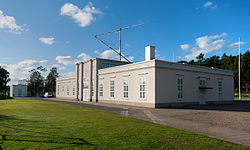| Grimeton Radio Station | |
|---|---|
Grimeton Radiostation (Swedish) | |
 The main building with a log-periodic antenna from the 1960s in the background. | |
 Interactive fullscreen map | |
| General information | |
| Architectural style | Nordic Classicism |
| Location | Grimeton, Varberg Municipality, Halland County, Sweden |
| Coordinates | 57°6′50.4″N 12°24′15.8″E / 57.114000°N 12.404389°E |
| Construction started | November 1922 |
| Completed | 24 May 1925 |
| Opened | 1 December 1924 |
| Inaugurated | 2 July 1925 |
| Owner | Stiftelsen Världsarvet Grimeton |
| Website | |
| grimeton | |
| Official name | Grimeton Radio Station, Varberg |
| Criteria | Cultural: ii, iv |
| Reference | 1134 |
| Inscription | 2004 (28th Session) |
| Area | 109.09 ha |
| Buffer zone | 3,854 ha |

Grimeton Radio Station (Swedish pronunciation: [ˈɡrɪ̂mːɛˌtɔn])[1] in southern Sweden, close to Varberg in Halland, is an early longwave transatlantic wireless telegraphy station built in 1922–1924, that has been preserved as a historical site. From the 1920s through the 1940s it was used to transmit telegram traffic by Morse code to North America and other countries, and during World War II was Sweden's only telecommunication link with the rest of the world. It is the only remaining example of an early pre-electronic radio transmitter technology called an Alexanderson alternator. It was added to the UNESCO World Heritage List in 2004, with the statement: "Grimeton Radio Station, Varberg is an exceptionally well preserved example of a type of telecommunication centre, representing the technological achievements by the early 1920s, as well as documenting the further development over some three decades." The radio station is also an anchor site for the European Route of Industrial Heritage.[2] The transmitter is still in operational condition, and each year on a day called Alexanderson Day is started up and transmits brief Morse code test transmissions, which can be received all over Europe.
- ^ Jöran Sahlgren; Gösta Bergman (1979). Svenska ortnamn med uttalsuppgifter (in Swedish). p. 9.
- ^ "ERIH Entry: Varberg World Heritage radio station". European Route of Industrial Heritage. 2014. Retrieved 15 January 2015.